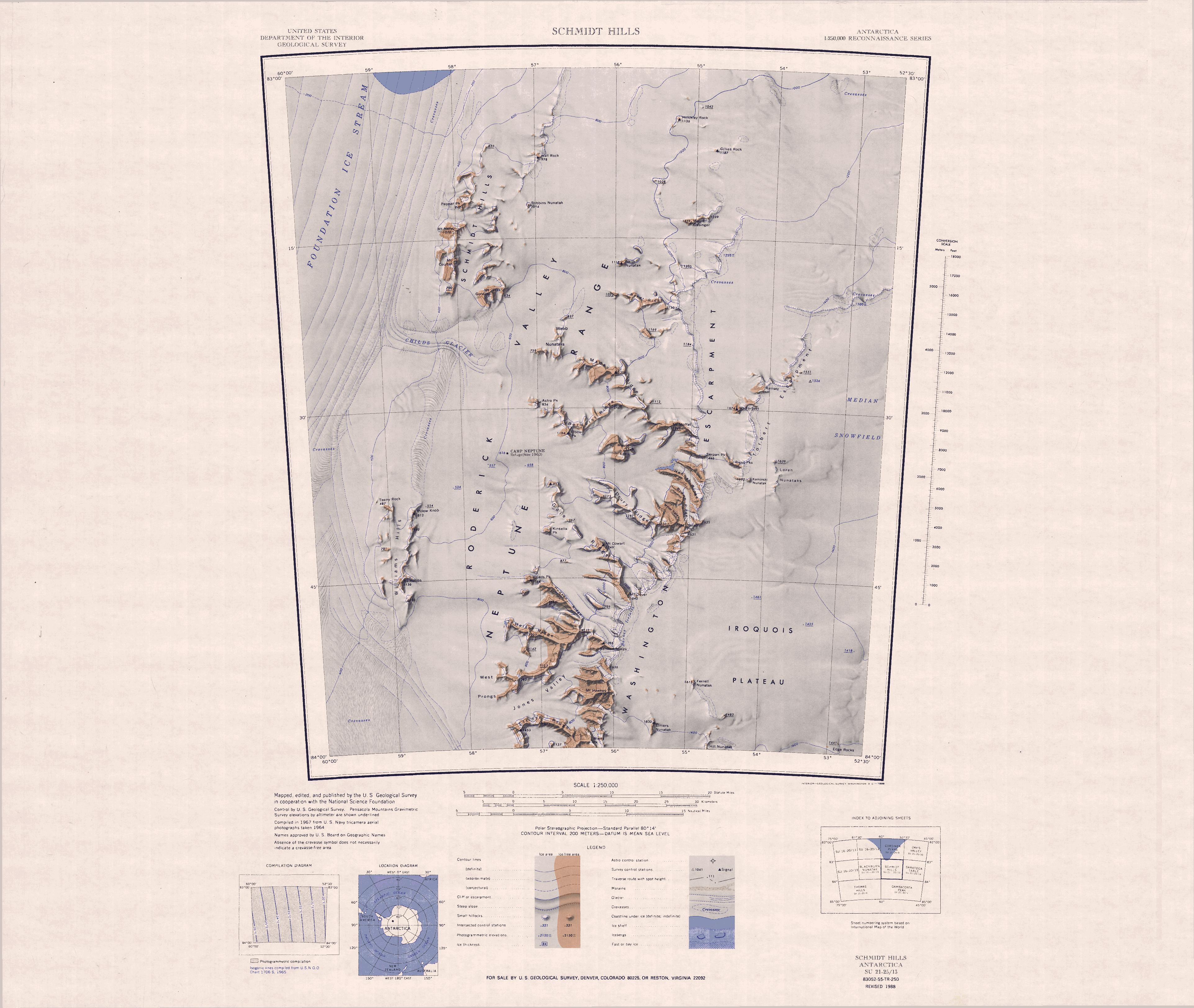Mount Nervo on:
[Wikipedia]
[Google]
[Amazon]
Schmidt Hills () is a group of rock hills, long, lying north of Childs Glacier and west of Roderick Valley in the Neptune Range of the
 The Schmidt Hills are in the northwest of the Neptune Range on the east side of the
The Schmidt Hills are in the northwest of the Neptune Range on the east side of the
Pensacola Mountains
The Pensacola Mountains are a large group of mountain ranges of the Transantarctic Mountains System, located in the Queen Elizabeth Land region of Antarctica.
Geography
They extend 450 km (280 mi) in a NE-SW direction. Subranges of the ...
, Antarctica.
Mapping and name
The Schmidt Hills were mapped by theUnited States Geological Survey
The United States Geological Survey (USGS), formerly simply known as the Geological Survey, is a scientific agency of the United States government. The scientists of the USGS study the landscape of the United States, its natural resources, ...
(USGS) from surveys and United States Navy
The United States Navy (USN) is the maritime service branch of the United States Armed Forces and one of the eight uniformed services of the United States. It is the largest and most powerful navy in the world, with the estimated tonnage ...
air photos and 1956–1966. They were named by the United States Advisory Committee on Antarctic Names
The Advisory Committee on Antarctic Names (ACAN or US-ACAN) is an advisory committee of the United States Board on Geographic Names responsible for recommending commemorative names for features in Antarctica.
History
The committee was established ...
(US-ACAN) for Dwight L. Schmidt, USGS geologist to the Pensacola Mountains in 1962–63, 1963–64 and 1965–66.
Location
 The Schmidt Hills are in the northwest of the Neptune Range on the east side of the
The Schmidt Hills are in the northwest of the Neptune Range on the east side of the Foundation Ice Stream
Foundation Ice Stream is a major ice stream in Antarctica's Pensacola Mountains. The ice stream drains northward for along the west side of the Patuxent Range and the Neptune Range to enter the Ronne Ice Shelf westward of Dufek Massif. The Unit ...
near the point where it joins the Ronne Ice Shelf.
They are north of the Williams Hills and west of the northern end of the Washington Escarpment, from which they are separated by the Roderick Valley.
Features include, from south to north, Mount Gorecki, Mount Coulter, Mount Nervo, Pepper Peak, Robbins Nunatak and Wall Rock.
Features
Mount Gorecki
. A mountain, high, at the southeast extremity of Schmidt Hills. It was discovered and photographed on January 13, 1956 on a United States Navy transcontinental non-stop plane flight from McMurdo sound to Weddell Sea and return. It was named by US-ACAN for aviation electronics technician Francis Gorecki, radioman of the P2V-2N aircraft making the flight.Mount Coulter
. A mountain northwest of Mount Gorecki. It was named by US-ACAN for LeRoy G. Coulter, cook at Ellsworth Station, winter 1958.Mount Nervo
. A mountain, high, standing north of Mount Coulter. The mountain was named by US-ACAN for George W. Nervo, radioman at Ellsworth Station, winter 1958.Pepper Peak
. A sharp peak, high, standing north of Mount Nervo. It was named by US-ACAN for Clifford G. Pepper, hospital corpsman at Ellsworth Station, winter 1958.Robbins Nunatak
. A conspicuousnunatak
A nunatak (from Inuit ''nunataq'') is the summit or ridge of a mountain that protrudes from an ice field or glacier that otherwise covers most of the mountain or ridge. They are also called glacial islands. Examples are natural pyramidal peaks. ...
northeast of Mount Gorecki. It was named by US-ACAN for Edward J. Robbins, aerographer at Ellsworth Station, winter 1958.
Wall Rock
. A rock north of Robbins Nunatak. The rock was named by US-ACAN for John Wall, a member of the Electronic Test Unit in the Pensacola Mountains, 1957–58.Roderick Valley
. A large ice-filled valley trending in a north-south direction and separating Schmidt Hills and Williams Hills from the main mass of the Neptune Range. It was named by US-ACAN for Captain David W. Roderick, United States Air Force, pilot and second in command of the Electronic Test Unit in the Pensacola Mountains, 1957–58.References
Sources
* * * {{Authority control Hills of Queen Elizabeth Land Pensacola Mountains